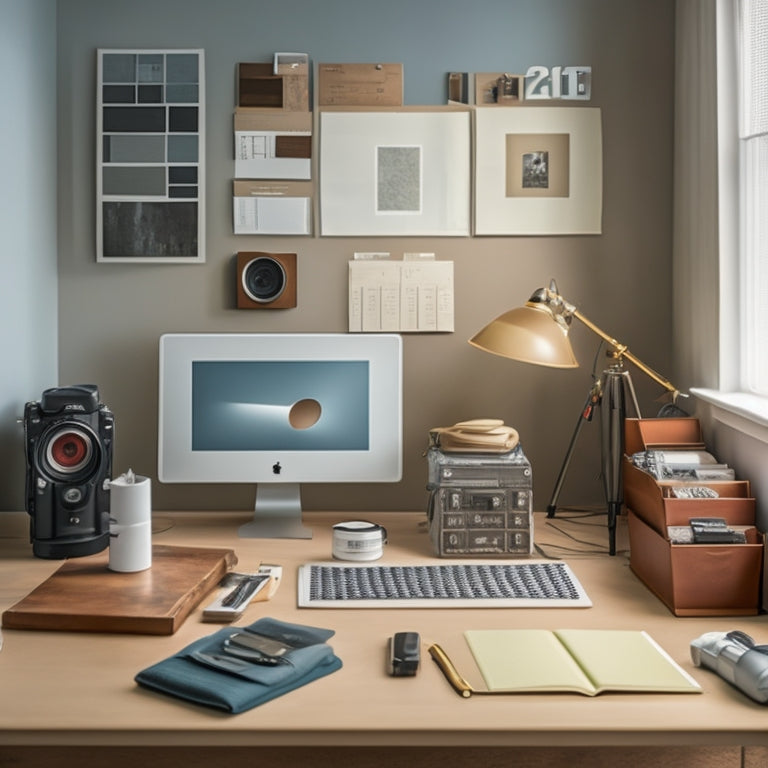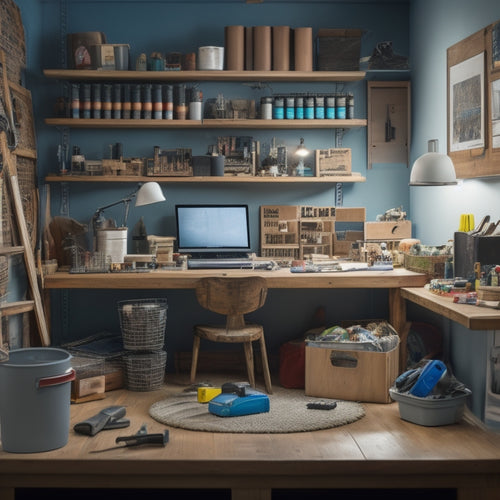
Efficient Workflow: Mastering Photography Organization Basics
Share
As I've refined my photography workflow, I've come to realize that mastering organization basics is essential to efficiency. I prep by separating camera bodies from lenses, using multiple CF cards, and having a backup camera on hand. Post-shoot, I download images to an external hard drive, format cards in-camera, and backup my Lightroom catalog regularly. By streamlining my editing workflow and following a strict file naming convention, I can focus on delivering high-quality images to clients on time. By implementing a structured organization system and staying consistent, I'm able to stay ahead of the game and continuously improve my craft.
Key Takeaways
• Implement a structured organization system to streamline post-shoot workflow and ensure efficient image management.
• Download images to an external hard drive to free up camera storage and prevent data loss.
• Use a consistent file naming convention to easily locate and categorize images.
• Backup the Lightroom catalog regularly to protect valuable editing work and metadata.
• Carry multiple external hard drives for added security and redundancy in storing and backing up image files.
Camera Gear and Preparation Essentials
I always make certain that my primary camera, a Canon 5D MKIII, is fully prepared for a shoot by starting with a fully charged battery and a Transcend 32GB CF card. I own multiple CF cards in various sizes - 4x 32GB, 3x 16GB, and 2x 8GB - and carry them all for long events or travel.
I swap cards at logical breaks and store used and fresh cards separately to avoid mix-ups. From past experiences, I've learned to place used CF cards in a separate pouch to prevent card failures. This card maintenance and storage routine ensures I'm always ready for any shoot.
Additionally, I take backup precautions seriously, carrying a backup camera, Canon 5D MKII, for international travel and using multiple storage devices to safeguard my files.
Streamlining Post-Shoot Organization
After capturing a batch of images, separating camera bodies from lenses for storage helps guarantee scratches and damage, while also making it easier to transport and access equipment during post-shoot organization. Next, I download images to an external hard drive and format the cards in-camera. I use Seagate external hard drives for storage and delete my Photos library annually.
| Storage Device | Capacity |
|---|---|
| Seagate External Hard Drive | 2TB |
| WD My Passport Ultra | 1TB |
| Transcend 32GB CF Card | 32GB |
I backup my Lightroom catalog on the Seagate drive and copy RAW files after each trip. This ensures that my files are safe and easily accessible, allowing me to focus on file management and backup strategies. By streamlining my post-shoot organization, I can efficiently manage my files and prepare for editing.
Editing Workflow and Delivery Best Practices
With a solid organizational system in place, I can now focus on refining my editing workflow to guarantee efficient and high-quality delivery of final images.
I prioritize client communication, ensuring they're informed throughout the editing process. Image curation is vital, as I carefully select the best shots to deliver. I follow a strict file naming convention, including the client's name, shoot date, and image number, making it easy to locate specific files.
Storage solutions are also essential; I use external hard drives, like my trusted WD Ultra, to store and transport edited files. By maintaining a consistent workflow, I can confidently deliver high-quality images that meet my clients' expectations, while also streamlining my editing process.
Genre-Specific Photography Tips and Tricks
Whether capturing the majesty of landscapes or the intimacy of portraits, understanding the unique demands and techniques of each genre is crucial for producing exceptional photography. As I've honed my skills, I've learned to adapt to the specific needs of each genre.
Here are some essential tips to keep in mind:
-
For landscape photography, focus on composition techniques like leading lines and framing, and experiment with lighting conditions to enhance colors and details in post-processing.
-
In portrait photography, establish a connection with your subject to capture authentic expressions, and utilize natural or artificial lighting setups to create the desired mood.
-
Pay attention to background elements that complement the subject, and use post-processing techniques for retouching and enhancing portraits.
Mastering these genre-specific techniques will elevate your photography and help you produce stunning images that tell a story.
Mastering Photography Organization Systems
By implementing a structured organization system, I've been able to streamline my photography workflow, reduce stress, and focus on what matters most: capturing exceptional images.
My file management strategy involves downloading images to an external hard drive and formatting cards in-camera. I use Seagate external hard drives for storage and backup my Lightroom catalog regularly.
On the road, I carry two WD My Passport Ultra external hard drives for added security. This system allows me to optimize my workflow, ensuring that I can efficiently edit and deliver high-quality images to clients.
Frequently Asked Questions
How Do I Prioritize and Manage Multiple Photo Shoots Simultaneously?
'I prioritize multiple shoots by scheduling them meticulously, delegating tasks to assistants when possible, and creating a detailed checklist for each shoot to guarantee a smooth, efficient workflow, and delivering high-quality images to my clients.'
What Strategies Can I Use to Stay Organized During Long Events or Travel?
When traveling or covering long events, I prioritize packing essentials like multiple CF cards, external hard drives, and a portable Lightroom catalog, using travel hacks like separate pouches for used cards and organized storage to guarantee a seamless workflow.
How Often Should I Backup My Files and Lightroom Catalog?
"As I navigate the digital Wild West, I backup my files to external drives daily and sync my Lightroom catalog to cloud storage weekly, ensuring my creative treasures are safely tucked away from digital outlaws."
Are There Any Specific Software or Tools for Managing Client Relationships?
"I rely on client relationship management tools like HoneyBook and Dubsado, which offer a client portal for seamless communication and project tracking, ensuring I stay organized and focused on delivering exceptional service to my clients."
What Are Some Ways to Maintain Consistency in My Photography Style?
Like a painter with a signature brushstroke, I craft my visual identity by consistently applying a distinct brand aesthetic to every shoot, ensuring cohesive imagery that resonates with my audience and sets my photography apart.
Related Posts
-

What Makes Effective Online DIY Home Organization Courses?
You're about to reveal the secrets to transforming your living space into a serene and functional oasis, and it all b...
-

Mastering Small Closet Organization: Proven Strategies Unlocked
You're about to reveal the secret to transforming your small closet into a functional haven, where every item has its...
-

What Makes the Best DIY Storage Ottoman?
When constructing your ideal DIY storage ottoman, consider essential features like color, size, upholstery, and compl...


